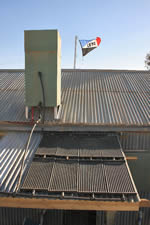Introduction
Marree, the home of the Lake Eyre Yacht
Club, is in one of the hottest and sunniest areas of Australia. It
is also within the boundaries of Australias Great Artesian Basin (GAB)
and mineralised artesian bore water is the only town water supply.
This water is corrosive and eats out conventional storage hot water
services quickly. An all plastic solution to hot water supply should
have benefits and so this design was developed around polythene drums
and polythene solar collectors. The catch being - is polythene
able to withstand the high temperatures of a 50 degree day in Marree?
Well, given that the desert is covered in black polypipe for stock
watering I'm hoping it is. If the system is still intact after this
coming summer it will have passed the heat test. After installation
in September it was subject to a few 38 degree days with no problems
so it should be OK for seaboard locations
Typically we were able to have two very
hot showers late afternoon plus dishwashing hot water or two warm to
hot showers in the morning. A washing machine could be used in the
middle of the day and with typical humidities less than 10%, clothes
dry before evening. Currently only half the planned number of collectors
are installed as we did not have enough timber to finish the verandah.
500 kms is a long way to go for a hardware store!
Search for Thermal Siphon Hot Water in Google
for full explanations of how the system works. Basically it uses the
principle that hot fluids/gasses rise. The system automatically circulates
cold water from the bottom of the tank through the collector -only
when the collector is hotter than the cold water - to be stored in
the top third, or more, of the tank. The only constraints to this design
are it is gravity fed - not mains pressure, and the collectors must
be at least 600mm below the bottom of the tank to ensure the thermal
siphoning works properly. In our situation this meant installing the
tank at the lowest part of the roof to make it as unobtrusive as possible
and placing the collectors on a verandah. The tank was placed directly
above the shower.
All plumbing is installed and serviced at
the front of the unit and hidden by a front panel.
| 
